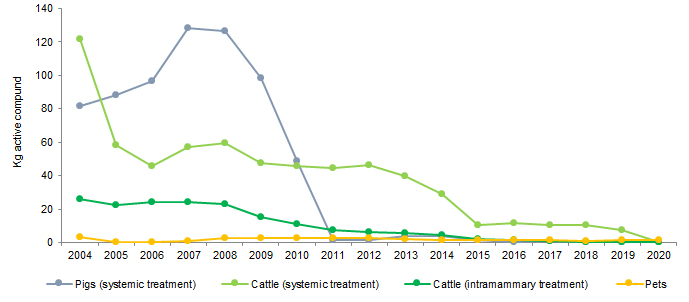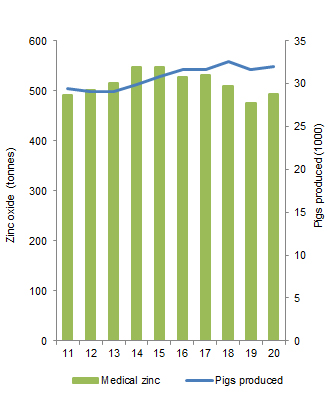The Danish cattle industry no longer uses third- and fourth-generation cephalosporins. As a result, these substances are no longer used in the production of Danish food producing animals. This is one of the findings in this year’s DANMAP report from Statens Serum Institut and the National Food Institute, Technical University of Denmark.
2020 marks the year when Danish pig and cattle producers reached their goal of phasing out their use of a type of critically important antimicrobials (third- and fourth-generation cephalosporins). At the end of the 2000’s, the two industries used more than 200 kilos of this type of antimicrobials in total.
Efforts to phase out the substances gathered momentum when the Danish ‘Yellow Card’ scheme was introduced in 2010. Under the scheme, the use of certain antimicrobials started to count significantly more in a pig herd’s antimicrobial account. By the following year, Danish pig producers used virtually no third- and fourth-generation cephalosporins.
From 2010, the cattle industry’s use of these substances to treat mastitis has steadily decreased until a virtual zero consumption was recorded in 2016. At the same time, the industry has worked towards a phasing out of systemic treatment of cattle using the substances—a goal they reached in 2020.
”The phasing out of critically important antimicrobials is a milestone that it is worth celebrating. Because if we are to have antimicrobials at our disposal, which can be used when other options for treating humans have been exhausted, we must continue to use antimicrobials in the agricultural sector with great care,” Senior Academic Officer Birgitte Borck Høg from the National Food Institute says.
Veterinarians still prescribe third- and fourth-generation cephaloporins for the treatment of pets. Treatment guidelines for pets has a focus on only prescribing them when absolutely necessary.

Figure caption: Development in the veterinary use of third- and fourth-generation cephalosporins in pigs and cattle from 2004 to 2020.
No decrease in the use of zinc oxide despite imminent ban
Following several years of slightly declining consumption of zinc oxide in the Danish pig production, consumption has increased to 494 tonnes in 2020, which is equivalent to an increase of approximately 4% from 2019.
The substance is mainly used to treat diarrhea in weaner pigs. From June 2022, an EU ban on the substance will come into force—to protect the environment and because use of the substance can lead to antimicrobial resistance.
“The figures in the DANMAP report show that there is no quick fix that the industry can apply, and there is still quite a way to go before achieving the zero use of zinc oxide that is lurking on the horizon,” Birgitte Borck Høg says.
The industry has launched several initiatives and participates in e.g. various research projects aimed at finding alternatives to using zinc oxide that will not result in an increased use of antimicrobials. Some pig farmers already produce pigs without the use of zinc oxide.

Figure caption: Development in the use of zinc oxide in pigs (in tonnes) from 2011 to 2020.
The pig industry has not reached new reduction target
Around 75% of the total veterinary-prescribed antimicrobials are used to treat pigs. From 2019 to 2020, consumption measured in kilograms has increased by 4.5%. However, if the use is instead calculated as the frequency with which pigs are treated with antimicrobials, the 2020 consumption is roughly equivalent to the previous year.
A new action plan aims to reduce antimicrobial use in pigs when measured in kilograms by 2% per year between 2019 and 2022 when compared with the use in 2018. With the measured increase in consumption between 2019 and 2020, the goal for the first year of the action plan has thus not been reached.
”After a number of years of declining antimicrobial use in pigs, it is unfortunate that this trend did not continue in 2020. This may make it difficult for pig producers to achieve the target set out in the action plan by 2022,” Birgitte Borck Høg says.
Read more
Since 1995, the DANMAP programme has monitored the use of antimicrobials in humans and animals in Denmark, and the occurrence of antimicrobial resistance in bacteria in animals, people and foods. Download the DANMAP report for 2020 from DANMAP’s website.
A factsheet about antimicrobial resistance is also available from the DANMAP website.
Find more information on how antimicrobial use in humans has developed in a press release on the DANMAP website: Antimicrobial use decreased further in Denmark during COVID-19.
- In 2020, 47% more antimicrobials were used to treat Danish poultry than the year before. The increase is mainly due to a high number of disease outbreaks in chicken flocks. However, antimicrobial use in chickens is generally very low.
- The aquaculture industry has recorded a 22% drop in the use of antimicrobials in 2020 compared with the year before. This is probably due to the fact that favorable weather conditions have triggered fewer disease outbreaks, which required treatment with antimicrobials.
- In 2020, the mink industry’s use of antimicrobials was on course to be lower than the year before. For obvious reasons, antimicrobial use ceased at the end of 2020, when most mink in Denmark had been culled.